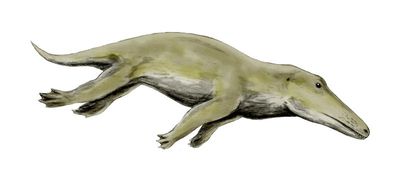
The 3 metre long Ambulocetus in its swimming posture. Its legs were strong enough that it could still walk on land. It lived in the Eocene period, roughly 50-49 million years ago.
Roughly five million years after Pakicetus first evolved, Ambulocetus[1] appears in the fossil record. Although its legs are strong enough to walk on land like Pakicetus, its hind legs are better adapted for swimming. It probably occupied an amphibious niche similar to that of modern crocodiles, hunting in shallow lagoons and occasionally lunging onto land to catch prey at the water's edge. It would have swum by undulating its back up and down like modern otters and whales (but unlike crocodiles or fish which flex side to side).
A tell-tale sign of its position between Pakicetus and modern whales is the structure of its inner ear. Like modern whales Ambulocetus was well-adapted to hearing underwater and may well have lost the ability to hear on land altogether[2].
Other whale-like features include its nose, which was adapted so that it could swallow underwater[3], and its teeth.
Ambulocetus was discovered in northern Pakistan. [Thewissen et al. 1992]
http://darwiniana.org/landtosea.htm: As Stephen Gould concludes, "If you had given me a blank piece of paper and a blank check, I could not have drawn you a theoretical intermediate any better or more convincing than Ambulocetus. Those dogmatists who by verbal trickery can make white black, and black white, will never be convinced of anything, but Ambulocetus is the very animal that they proclaimed impossible in theory." Natural History magazine, May 1994.
Squidoo on Ambulocetus - has great BBC video from "Walking with Prehistoric Beasts"
Their co-discoverer Thewissen has a page on Ambulocetidae.
Whales have certain adaptations for hearing underwater.
Ambulocetus has the thickened bullae lik Pakicetus but also the beginnings of a channel linking jaw to ear, which it may have used to pick up vibrations from the ground, as modern crocodiles do [Wong in SciAm pages 187-8 2002].
Modern whales can hear directionally.
Baleen whales (mysticetes) produce and receive low frequency sound for communicating. They have no teeth, but have evolved baleen for straining water for food.
Toothed whales (odontocetes) produce and receive high frequency sounds, enabling them to use echolocation for hunting.

Nasal drift of whales.
The nostrils of modern whales have become modified into blowholes that allow them to break to the surface, inhale, and submerge with convenience. The ears began to move inward as well, and, in the case of Basilosaurus, the middle ears began to receive vibrations from the lower jaw. Today's modern toothed whales use the 'melon organ', a pad of fat, for echolocation.
Nasal drift to top of head for blowhole http://www.edwardtbabinski.us/whales/evolution_of_whales/ (page is a drain)
[Thewissen et al. 1992] J. G. M. Thewissen, S. I. Madar, and S. T. Hussain (1996). "Ambulocetus natans, an Eocene cetacean (Mammalia) from Pakistan". Courier Forschungsinstitut Senckenberg 191: 186.
Author: Tom Brown
Copyright: public domain
Date last modified: 11th Oct 2011
Peer-review status: Not yet peer-reviewed
Ambulocetus: source: Wikipedia
Nasal drift: source: Babinski